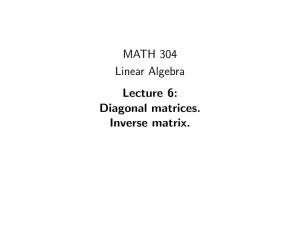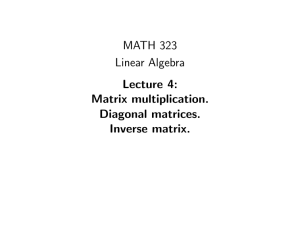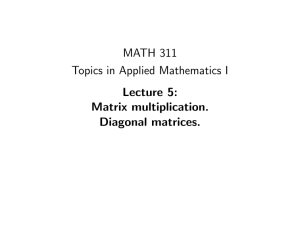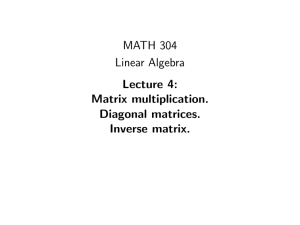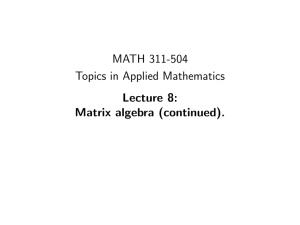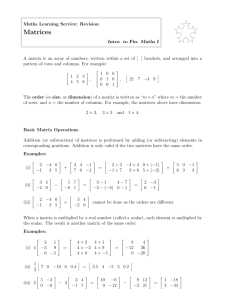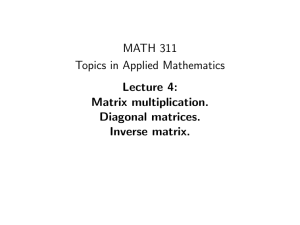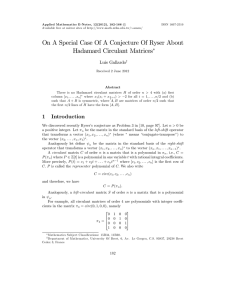Math 304–504 Linear Algebra Lecture 5: Matrix algebra (continued).
advertisement
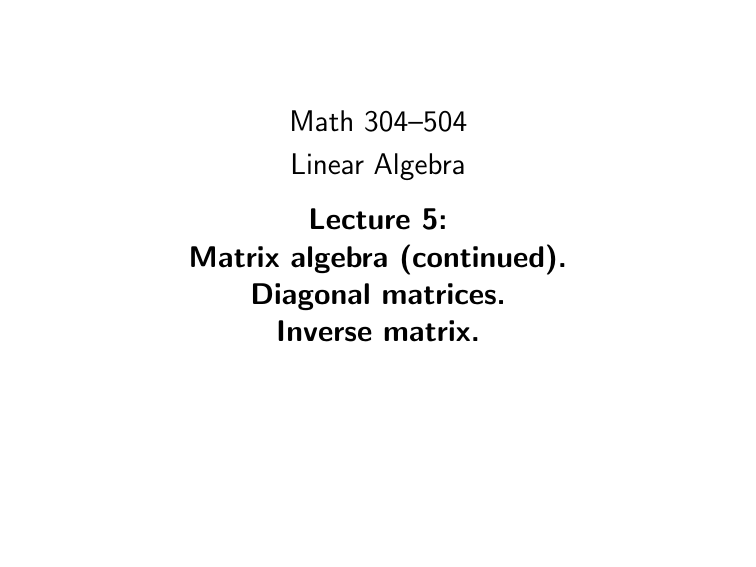
Math 304–504 Linear Algebra Lecture 5: Matrix algebra (continued). Diagonal matrices. Inverse matrix. Matrix addition Definition. Let A = (aij ) and B = (bij ) be m×n matrices. The sum A + B is defined to be the m×n matrix C = (cij ) such that cij = aij + bij for all indices i , j. That is, two matrices with the same dimensions can be added by adding their corresponding entries. a11 + b11 a12 + b12 b11 b12 a11 a12 a21 a22 + b21 b22 = a21 + b21 a22 + b22 a31 + b31 a32 + b32 b31 b32 a31 a32 Scalar multiplication Definition. Given an m×n matrix A = (aij ) and a number r , the scalar multiple rA is defined to be the m×n matrix D = (dij ) such that dij = raij for all indices i , j. That is, to multiply a matrix by a scalar r , one multiplies each entry of the matrix by r . ra11 ra12 ra13 a11 a12 a13 r a21 a22 a23 = ra21 ra22 ra23 ra31 ra32 ra33 a31 a32 a33 The m×n zero matrix (all entries are zeros) is denoted Omn or simply O. Negative of a matrix: −A is defined as (−1)A. Matrix difference: A − B is defined as A + (−B). As far as the linear operations (addition and scalar multiplication) are concerned, the m×n matrices can be regarded as mn-dimensional vectors. Properties of linear operations (A + B) + C = A + (B + C ) A+B =B +A A+O = O +A=A A + (−A) = (−A) + A = O r (sA) = (rs)A r (A + B) = rA + rB (r + s)A = rA + sA 1A = A 0A = O Dot product Definition. The dot product of n-dimensional vectors x = (x1, x2, . . . , xn ) and y = (y1, y2, . . . , yn ) is a scalar n X xk yk . x · y = x1 y1 + x2 y2 + · · · + xn yn = k=1 The dot product is also called the scalar product. Matrix multiplication Definition. Let A = (aik ) be an m×n matrix and B = (bkj ) be an n×p matrix. The product AB is defined to be the m×p matrix C = (cij ) such that P cij = nk=1 aik bkj for all indices i , j. That is, matrices are multiplied row by column: cij is the dot product of the i th row of A and the jth column of B. ∗ ∗ * ∗ ∗ ∗ ∗ ∗ ∗ ∗ ∗ ∗ ∗ * ∗ = * * * ∗ ∗ * ∗ ∗ ∗ * ∗ a11 a 21 A = .. . am1 b11 b 21 B = .. . bn1 a12 a22 .. . am2 . . . a1n v1 . . . a2n v2 = .. . . . ... . vm . . . amn b12 . . . b1p b22 . . . b2p .. . . . .. = (w1, w2, . . . , wp ) . . bn2 . . . bnp v1·w1 v1·w2 . . . v1·wp v ·w v ·w . . . v ·w 2 p 2 1 2 2 =⇒ AB = .. . .. . . . . . . . vm ·w1 vm ·w2 . . . vm ·wp Any system of linear equations can be represented as a matrix equation: a11x1 + a12x2 + · · · + a1n xn = b1 a21x1 + a22x2 + · · · + a2n xn = b2 ⇐⇒ Ax = b, ········· am1 x1 + am2 x2 + · · · + amn xn = bm where a11 a12 a 21 a22 A = .. .. . . am1 am2 . . . a1n . . . a2n , . . . ... . . . amn x1 b1 x b 2 2 x = .. , b = .. . . xn bm a11x1 + a12 x2 + · · · + a1n xn = b1 a21x1 + a22 x2 + · · · + a2n xn = b2 ⇐⇒ Ax = b ········· am1 x1 + am2 x2 + · · · + amn xn = bm Another representation of this system: b1 a1n a12 a11 a b a a 2n 2 22 21 x1 .. + x2 .. + · · · + xn .. = .. . . . . bm amn am2 am1 Theorem The above system is consistent if and only if the vector b is a linear combination of the column vectors of A. Properties of matrix multiplication: (AB)C = A(BC ) (associative law) (A + B)C = AC + BC (distributive law #1) C (A + B) = CA + CB (distributive law #2) (rA)B = A(rB) = r (AB) Any of the above identities holds provided that matrix sums and products are well defined. If A and B are n×n matrices, then both AB and BA are well defined n×n matrices. However, in general, AB 6= BA. 2 0 1 1 Example. Let A = , B= . 0 1 0 1 2 2 2 1 Then AB = , BA = . 0 1 0 1 If AB does equal BA, we say that the matrices A and B commute. Problem. Let A and B be arbitrary n×n matrices. Is it true that (A − B)(A + B) = A2 − B 2? (A − B)(A + B) = (A − B)A + (A − B)B = (AA − BA) + (AB − BB) = A2 + AB − BA − B 2 Hence (A − B)(A + B) = A2 − B 2 if and only if A commutes with B. Diagonal matrices If A = (aij ) is a square matrix, then the entries aii are called diagonal entries. A square matrix is called diagonal if all non-diagonal entries are zeros. 7 0 0 Example. 0 1 0, denoted diag(7, 1, 2). 0 0 2 Let A = diag(s1, s2, . . . , sn ), B = diag(t1, t2 , . . . , tn ). Then A + B = diag(s1 + t1 , s2 + t2 , . . . , sn + tn ), rA = diag(rs1, rs2, . . . , rsn ). Example. 7 0 0 −1 0 0 −7 0 0 0 1 0 0 5 0 = 0 5 0 0 0 2 0 0 3 0 0 6 Theorem Let A = diag(s1, s2, . . . , sn ), B = diag(t1, t2, . . . , tn ). Then A + B = diag(s1 + t1 , s2 + t2 , . . . , sn + tn ), rA = diag(rs1, rs2, . . . , rsn ). AB = diag(s1t1, s2t2 , . . . , sn tn ). In particular, diagonal matrices always commute. Example. 7a11 7a12 7a13 7 0 0 a11 a12 a13 0 1 0 a21 a22 a23 = a21 a22 a23 2a31 2a32 2a33 a31 a32 a33 0 0 2 Theorem Let D = diag(d1, d2, . . . , dm ) and A be an m×n matrix. Then the matrix DA is obtained from A by multiplying the i th row by di for i = 1, 2, . . . , m: d1 v1 v1 d v v 2 2 2 A = .. =⇒ DA = .. . . dm vm vm Example. 7 0 0 7a11 a12 2a13 a11 a12 a13 a21 a22 a23 0 1 0 = 7a21 a22 2a23 7a31 a32 2a33 0 0 2 a31 a32 a33 Theorem Let D = diag(d1, d2, . . . , dn ) and A be an m×n matrix. Then the matrix AD is obtained from A by multiplying the i th column by di for i = 1, 2, . . . , n: A = (w1, w2, . . . , wn ) =⇒ AD = (d1w1 , d2w2 , . . . , dn wn ) Identity matrix Definition. The identity matrix (or unit matrix) is a diagonal matrix with all diagonal entries equal to 1. The n×n identity matrix is denoted In or simply I . 1 0 0 1 0 I1 = (1), I2 = , I3 = 0 1 0 . 0 1 0 0 1 1 0 ... 0 0 1 . . . 0 In general, I = .. .. . . . .. . . . . 0 0 ... 1 Theorem. Let A be an arbitrary m×n matrix. Then Im A = AIn = A. Transpose of a matrix Definition. Given a matrix A, the transpose of A, denoted AT , is the matrix whose rows are columns of A (and whose columns are rows of A). That is, if A = (aij ) then AT = (bij ), where bij = aji . T 1 4 1 2 3 = 2 5 , Examples. 4 5 6 3 6 T T 7 4 7 4 7 8 = (7, 8, 9), = . 7 0 7 0 9 Definition. A square matrix A is said to be symmetric if AT = A. Properties of transposes: • (AT )T = A • (A + B)T = AT + B T • (rA)T = rAT • (AB)T = B T AT • (A1 A2 . . . Ak )T = ATk . . . AT2 AT1 Proposition Given any matrix A, the products AAT and AT A are well defined symmetric matrices. Proof: Suppose A is an m×n matrix. Then AT is an n×m matrix. Hence AAT and AT A are well defined. AAT is an m×m matrix while AT A is an n×n matrix. (AAT )T = (AT )T AT = AAT , (AT A)T = AT (AT )T = AT A. Inverse matrix Let Mn (R) denote the set of all n×n matrices with real entries. We can add, subtract, and multiply elements of Mn (R). What about division? Definition. Let A ∈ Mn (R). Suppose there exists an n×n matrix B such that AB = BA = In . Then the matrix A is called invertible and B is called the inverse of A (denoted A−1). A non-invertible square matrix is called singular. AA−1 = A−1A = I Basic properties of inverse matrices: • If B = A−1 then A = B −1. In other words, if A is invertible, so is A−1 , and A = (A−1 )−1. • If AB = CA = I for some matrices B, C ∈ Mn (R) then B = C = A−1 . Indeed, B = IB = (CA)B = C (AB) = CI = C . • If matrices A, B ∈ Mn (R) are invertible, so is AB, and (AB)−1 = B −1A−1. (B −1A−1)(AB) = B −1(A−1A)B = B −1IB = B −1B = I , (AB)(B −1A−1 ) = A(BB −1)A−1 = AIA−1 = AA−1 = I . −1 −1 • Similarly, (A1A2 . . . Ak )−1 = A−1 k . . . A2 A1 .
